|
FAQs on Paravortex, Black
Spot, Black "Ich", Turbellarian Worm Disease,
Diagnosis/Symptomology
Related Articles: Marine
Parasitic Disease, Parasitic
Worms, Roundworms,
Related FAQs on
Blackspot Disease: Black Spot
Disease 1, Black Spot Disease 2,
Etiology/Prevention, Cures That Don't Work, Cures That Do Work, Products/Manufacturers...
& Fish Worm
Diseases 1, Marine Worm Parasites 2, Marine Worm Parasites 3, & FAQs on
Marine Worm Parasites: Diagnosis/Symptomology, Etiology/Prevention, Cures That Don't Work, Cures That Do Work, Products/Manufacturers... Flukes/Trematodes, Tapeworms/Cestodes, Leeches/Hirudineans, "Other" Worms and Worm-Like
Parasites... & Yellow Tang Disease, Parasitic Disease 2, Parasitic Disease 3, Parasitic Marine Tanks, Parasitic Reef Tanks,
Cryptocaryoniasis, Marine
Ich, Marine Velvet Disease Biological Cleaners,
Treating Parasitic Disease,
Using Hyposalinity to Treat
Parasitic Disease, Roundworms, Yellow Tangs, Tang
Health/Disease,
|
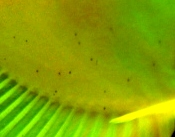 Likely
Paravortex Likely
Paravortex
|
|
Powder brown tang w/ black spots
11/4/10
Hi Crew,
<Hi Donald>
I currently have a powder brown tang that I put through QT for a
month with Cupramine. It has black spots on it but I noticed that
it didn't seem to affect him at all other than the fact he
seems pale. No scratching, rapid breathing, or loss of appetite,
so I added it to my display. I'm just curious as to what
these black spots are. Is it black ich? If so, can I just leave
him be because he's eating well and has put on substantial
weight? I have 3 cleaner shrimp in my tank.
<This does look like it to me.. have you read here?
http://www.wetwebmedia.com/paravortexfaqs.htm. You should have
freshwater dipped this fish before introduction to the display,
might be worth doing this now... and seeing if you can control
it, otherwise it's removal to QT while your system goes
fallow for a month or more I'm afraid>
Here is a picture, it's not mine but the spots are
similar:
[cid:image001.png@01CB7C24.4155F3D0]
<Good picture>
Thanks,
Donald
<Simon>
|
|
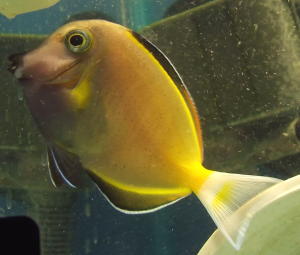 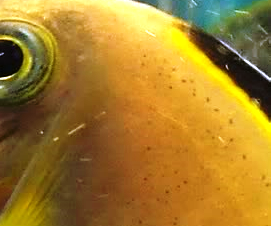
|
Black ich on powder brown tang 5/15/10
Hey crew,
<Don>
I bought a 4 inch powder brown tang a about 2 weeks ago. I did not QT
as I did not want to stress the tang out in a small QT (as I've
heard about powder blues dying in QT)
<I would at least run such species through prophylactic pH adjusted
freshwater baths ahead of placing in display tanks>
I placed the tang in the display and its been eating Nori and Ulva.
This week, I started noticing small black spots that I believe to be
black ich.
<Might be... could be Trematodes, Sporozoans...>
They are relatively small and dull and I've seen the tang trying to
rub against the sand.
<Some of this behavior to be expected>
I read through some of your FAQs about black ich and it seems that you
recommend waiting before trying to capture the tang (due to undue
stress on the fish of chasing it down etc). I just wanted to know, how
long should I wait before I should try catching it?
<I'd "try" purposeful cleaners first... Read here re:
http://wetwebmedia.com/biocleaners.htm
and the linked FAQs file above>
Everyone recommends doing a FW dip or formalin. Are there any other
methods of ridding the infestation in which I can keep the tang in the
display?
<See above and what is archived on WWM re Paravortex>
For example, would using PraziPro and keeping the tang well fed allow
him to fight off the worms?
<If this/these are worms... might work>
Thanks,
Donald
<Welcome. Bob Fenner>
Re: Black ich on powder brown tang 5/16/2010
Thanks for responding Bob.
<Welcome>
I have two cleaner shrimp and two neon gobies in my system. I have
noticed that the powder brown has been requesting cleaning from the
Neons, but have not witnessed anything from the shrimp.
As for the powder brown, I noticed it was breathing more rapidly today.
It is still nibbling on Nori, but I am concerned by the rapid
breathing.
Should I let him be or do a fresh water/formalin dip?
<Is one approach. B>
Its my water change day, so I plan to dose PraziPro to the tank
again.
Please let me know what the best course of action is. Thanks again
Bob!
Re: Black ich on powder brown tang -- 5/18/10
Hey Bob,
Which would you recommend first, the FW dip or the formalin?
<... the formalin in the pH-adjusted FW bath... Please don't
write w/o searching, reading first... Here this time:
http://wetwebmedia.com/mardisindex.htm
the first tray... "Dips/Baths"... "Additives...>
What's the best way to catch the tang without stressing it?
<... there is no such thing>
Also, say if I can't catch the tang, what should I do to ensure the
tang remains healthy?
<... read on WWM re the species, genus, family...>
Is there any way to prevent reinfestation?
<Yes>
I will try and take a picture tonight to confirm if it's black ich
or not.
<Non-magnified photos will not discern cause here. B>
Thanks,
Donald
|
Black spot, maybe not 12/26/08 Hi
there, <Hello Dan> Sorry to be a bother, but I have a
confusing situation over here. I have a 90 gallon reef tank with;
yellow tang, blue tang, two clown fish, anemone, clam, cleaner
shrimp, sally light foot, purple lobster, leather corals, hammer
corals, some polyps, mushrooms and other bits and pieces. As well
as about ten, well established mangroves growing in my sump
refugium. Everything was going quite well until I added a yellow
eyed Kole tang (which I do love) to my reef. Two weeks later I
noticed black bumps and some color fading appearing on my blue
tang. As well as some lateral line and forehead peeling on my
yellow tang. So I went on the Internet and found your site. I
think my blue tang has the black spot disease, <Mmm...
actually... you would very likely see this now, concurrently on
the Yellow, Zebrasoma flavescens... I think you may be witnessing
Microsporideans... not really treatable... and not very
debilitating> but I didn't notice any info about the spots
kind of bumping out a bit, <Good description... and likely
shiny, kind of shaped like cones... whereas Paravortex is dull,
flat...> and one day he was fine and the next he has 20 spots
on him. So I am guessing I need to quarantine him, but what about
the Kole (who is fine except for only eating off the rocks so
far) and yellow tang? <Again... or for emphasis, I would NOT
move these fishes... at least as yet...> I think I can deal
with the yellow tang as it seems as his peeling is do to poor
water quality <?! What leads you to think this?> and
stress. I am about to do a water change and hook the skimmer back
up (after two years off due to the mangroves). <I would>
Should I quarantine all of the tangs? can I do them all together?
What product would you recommend? <No, yes, None> Could I
do it in my mangrove tank or will the medicine possibly hurt
them? <Depending on what's used, yes> Sorry again and
thank you for your help. I have never had a sick fish before and
was upset to see him, I do have a good photo if needed and also
don't know how to find this page again. <Mmm, should be
here with your message/response. Please do send the image
along> Thank you Dan <Welcome. Bob Fenner>
black spot, maybe not 12/27/08 Hi there again
Bob. <Dan> I was worried about waiting another day to treat
my fish, so I made a executive decision and went against your
advice to wait to move the three tangs into a quarantine. I see
why you said wait as it does seem to cause a lot of stress (for
the fish and my girlfriend and I) to try to catch them. I was
only able to catch the infected blue tang, but did so without
disturbing my reef which seemed good as I have seen what happens
when you start moving rocks around. I went to my LFS and showed
them the same photo of the blue tang I sent you, <I still
haven't seen this image> and he told me to quarantine all
three and to treat the fish with aquarium Munster proto Marin
Intensiv, <What are the ingredients here?> which I did do.
I was reading the instructions and noticed that it said nothing
of treating black spot or Microsporideans. I know I should have
waited until you saw the photos but he seemed to be getting worse
and I wanted to get him treated as soon as possible. I have the
feeling I am not treating him with the right medication. What
should I do now? <...> I know you will have probably
answered all my questions in my second email but just in case,
should I keep treating him with the proto Marin, and if not than
what? >... nothing< should I catch and quarantine the other
tangs? <... already answered> What about the other fish?
<... How would I, anyone be able to determine what is actually
going on here?> I have been reading about dips - would you
recommend doing this? and should I keep my fish quarantined for
4-6 weeks? also I have a Marineland hot magnum that came with
cloth like filter like those in vacuums, would this work for my
hospital tank? or if not could I fill it up and run it with the
sponge filters? Sorry for going ahead as I have read some of your
articles where people did the same thing and they seemed
annoying. Also sorry for two emails at once, I just wanted to
keep you posted and if you thought the blue tang would be better
off back in the reef tank, another day would not have gone by.
Thanks so much for all your help. I appreciate it. Dan. <...
Please, see, read on WWM re Acanthurid Health, Protozoans,
Infested Systems... B>
black spot, maybe not 12/27/08 Hi Bob Thank
you for getting back to me so fast. What lead me to believe that
the yellow tangs peeling is do to poor water quality is that, It
had happened to him before and when I started trying to improve
my water quality it went away. He may have started peeling before
I introduced the Kole tang, and I have noticed that a lot of the
yellow tangs in LFS do have the same problems. I guess I
diagnosed him with the head and lateral line disease. I did have
a few mangroves slowly die in my sump a few months back when on
vacation, and when I questioned the guy at the LFS about his
peeling he guessed that my nitrites were high, which they were,
and said it generally happens when water quality is low and they
are stressed. Do you think thou I could be wrong and my yellow
tangs problem could be related to the blue tangs black spots?
<Mmm, indirectly, yes... the pitting is very likely mostly due
to "poor water quality"... is a type/form of
HLLE...> I should mention that all of my fish are acting
normal and are as hungry as ever, thou I have noticed the blue
tang rubbing a bit on the live rock. I couldn't find any
information on Microsporideans. Will my other fish be affected if
I do not quarantine the blue tang? I read some where to remove
activated carbon, I run Chemi-pure in a hang on filter should I
switch it off or change products? <... I would keep using the
Chemi-pure> As for the blue tangs bumps, on the blue part of
his body there are bumps with a black spot in the middle and
around the spot on the rising sides of the bump seems to be
whitish. However on his black markings he seems to only have one
or two white spots, and on his fins and tail just black dots no
bumps. Does this sound like Microsporideans? <Could be...
but... net cause/s?> Is there anything I should do? Hopefully
the photos are usable and helpful. Thank you very much for your
time Dan <Keep reading. BobF>
|
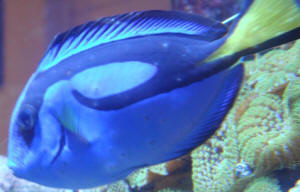 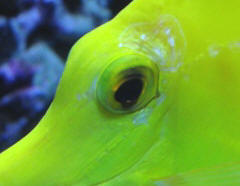 |
|
black spot maybe not... Not reading? Definitely!
12/27/08 Hi Bob, The product I was recommended to treat
my tangs with was Protomarin Intensiv. It says 1 ml contains 20
mg of copper(II) sulfate penta hydrate, <... toxic... You do
have a copper test kit I hope... and have read... re copper
use...> and 1 mg tetamethyl-4, 4-diamino-triphenyl-carbinol. I
followed the instructions for day one, and when I got up this
morning there were about 10 black worm like things floating
around on the bottom which seemed promising. I am sorry to ask
this again but given the new information and photo of the blue
tang, If this was your tank would you quarantine the other tangs
as well? I assume I should because my Kole tang is the one who
carried the disease in, and my yellow tang is weakened by the
HLLE. Thank you Dan <There is no sense
"quarantining" anything here... B> Re: black spot
maybe not Hi bob <dan> You have been so helpful so far. All
three of my tangs are in a quarantine tank now. I don't
understand why they shouldn't be qt?? <Read> there are
obvious spots all over one tang that must have come from my new
fish, as I have never had any problems before. Why is that
medicine toxic? <Ditto... Thanks Dan
|
Sailfin "Black Spot" only behind eyes?
12/22/08 Greetings crew, thank you in advance for your time
and wise, patient advice. <Welcome April> I have thought for the
past several weeks now that my Sailfin has Black Spot disease. He only
has those Black Spot looking pepper dots just behind his eyes, a small
cluster of them, about 7-10, all together, patterned like a half moon.
None anywhere else. <Mmm, something else> The rest of his body is
clear of any black dots. I have included a photo here of what my
guys' looks like. <No photo attached> (This is not my fish,
I've searched the web for an image to show you. I do not have
permission to use this photo publicly.) So, does this fish have Black
Spot? <Not if only behind the eyes, no> I see a little pitting on
this fish, like some sort of erosion, mine just has the few black dots
also seen here. So much research I have done on what this disease looks
like, and every source I have read discusses the dots over the entire
body, not just in one area as shown here. Are these handful of dots
cause for concern? Happy holidays! April. <The markings may be
symptomatic of HLLE... Please read here:
http://wetwebmedia.com/HLLESWCauseF.htm and the linked files above, and
try to send along a well-resolved pic if you can. Cheers, Bob
Fenner>
Help needed for black ich... hypo., no... Maybe not
Paravortex at all... 2/18/08 Dear WWM Crew, <Thomas> My
Achilles Tang is currently infested with both black and white spots.
The rest of the fish (no other tangs) seems ok except for a pale
looking potter angel. <Oh! Saw a few of these Centropyge yesterday
diving out at Crescent Beach, here in Hawaii> My tank previously had
a round of black n white ich a few months ago and I hypo the main tank
+ freshwater dip all fish + 1 month quarantine and managed to rid the
fish of both black and white spots <Uh, no... obviously> Now that
the black ich is back, is it true that even if I were to cure all my
fish of black ich, they will still come back since they are already in
my main tank and black ich can go for months without a host ? <Mmm,
not usually months, or even many weeks> I believe in minimising
stress on the fish and letting it recover the "natural way".
<Errr, not always, no... in the confines, conditions of aquariums,
lifetimes are shortened... vitality loss... sometimes lifetimes greatly
foreshortened...> This method works for me with regards to white
ich. But will it work the same for black ich? <Usually FW... This is
all gone over and over on WWM:
http://wetwebmedia.com/paravortexfaqs.htm and the linked files
above...> Thank you very much. Regards, Thomas Ong <And now...
this may not be "black ich" at all... but a trematode
infestation... Read on WWM re ID, treatment... Bob Fenner>
|
Black ick on yellow slug - I have attached a pic of it...
Actually marks on a Cuke... 1/9/08
G'day Crew, I have attached a close up pic of the ick on the
slug. I hope this is of assistance. many thanks, Ron
<Interesting... My old roommate, Mike Kent, worked on this
turbellarain (Paravortex) for his MSc... I don't think
"this is it"... but instead maybe just melanophores...
based as a guess, on the sort of regular arrangement here... but
a simple scrape, a low power microscope and possibly a little E
and O stain... and you'd be able to tell definitively. Bob
Fenner> G'day All, Thank you for this great resource. I
hope I am not asking something already posted but I haven't
seen anything about this problem yet. my first problem (that I
know of) in running a new tank for 18 months. I have recently got
Black Ick in my tank. my yellow tang showed spots about 8 weeks
ago, and on closer inspection I can see the black ick on my
yellow slug (not Nudibranch). <This is a holothuroid... a Sea
Cucumber... not a mollusk, but an echinoderm> I had been fw
dipping the tang and vacuuming during water changes to try to
break the cycle. <... please read here:
http://wetwebmedia.com/blkichf2.htm and the linked files
above> my question is - How to treat the yellow slug for the
black ich? <I wouldn't... don't think this is
"it"... will die off in the absence of useful (fish)
hosts...> I have moved my fish - yellow tang, pair of clowns,
dotty back and cardinal - and the slug and a banded shrimp into
my quarantine tank. the only ones with ick that I can see are the
tang and slug. I can freshwater dip the fish but what to do about
the slug???? as I understand inverts aren't keen on
hyposalinity/freshwater dips... my plan is to leave the main tank
fallow with its live rock, two anemones and handful of turbo
snails, for about 6 - 8 weeks to have the black ick in the system
die out. I would be doing reg water changes and try to vacuum out
any ick cysts on floor of tanks as I have no substrate in either,
and have UV filters running in both to try to zap free swimming
ick. then fresh water dip the fish and return them to the main
tank after 6-8 weeks. just don't know what to do for the
slug. (I was thinking of returning the shrimp to the main tank
tomorrow as I don't think he could host ick and it saves
trying to rinse him to be sure in 6 weeks time) any suggestions
would be great. Many thanks for your time and consideration, Ron.
<Read on my friend. Bob Fenner>
Re: black ick on yellow slug - I have attached a
pic of it 1/14/08 G'day Crew and Bob, thank you for
your input about my dilemma, and identifying the Colochirus
robustus. just getting back to you with regards to the black ick
being melanophores on the cucumber. the spots can be easily
brushed off the cuke, and so would appear not to be integral to
it but rather external parasites... <Agreed... perhaps these
are Turbellaria... just "space parasites" as it were...
not deriving nutrition, likely...> some are harder to
dislodge, but they tend to be resting in pits or folds and so are
hard to get at with the brush. <Microscopic examination...>
sadly, my yellow tang died in QT a day and a half after
transfer... he was at least 5 to 6 years old that I know of, and
had had some rough treatment before I began looking after him 18
months ago... perhaps stressed by the FW dip, transfer etc or a
secondary infection/gill damage from cysts affected him. that
leaves the cuke being the only inhabitant that I can see ick on.
it would be a bit of a coincidence for it to have contracted
something else that looks and behaves like ick when the tang came
down with it. checked the LFS where I got some turbo snails and
they have a yellow tang in the coral tank that the snails came
from and it was absolutely covered in ick..... <... as in
Crypt? Or Paravortex?> I am not able to get all the ick of the
cuke at one time, and I suspect that some ick are on it's
feeding hands too, as well as underneath in his feet etc... so I
don't know that physical removal is going to work in the
end.. would you have any other stabs at advice on this one? once
again, many thanks for your time, Ron. <It will die in time
(weeks) sans suitable fish host/s... Please... read where you
were referred to previously. RMF>
|
|
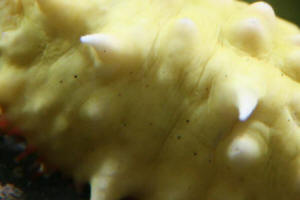
|
Black Ich??? 12/8/06 Hello folks,
<Robert> Get on you reading
glasses, this is gonna be a long one..........
<Got them on> I have a concern
about my marine fish that you will probably have an answer for, and it
deals with Black Ich. <The Turbellarian? Paravortex?> I
think. See, I just got up close to my fish tank for the
first time in a couple of days, and I noticed what appears to be a
parasite on my Yellow Tang and Percula Clown. In my
experience with fresh water fish, it appears to be my old pal Ich
paying a visit, but it instead of it being white, it is black and very
small....smaller than a grain of salt. There is a healthy
colony on both of these fish mentioned, my others don't appear to
have anything (Royal Gramma, Scooter Blenny (I know you hate to hear
about these in captivity, <Mmm, no... not at all... if
given/provided with adequate habitat, companions, opportunity for
foods...> but I bought one that eats frozen foods regularly from
both the fish dealer and now me, but then again, who knows....his days
could be numbered), <All of ours to a degree...> and a neon
goby. There are some other inhabitants including a brittle
star, emerald crab, a handful of snails. I also have some
random corals that came on my live rock, and that appear to be doing
quite well (blue mushroom polyps, various zoos, and a rather large colt
coral that was a gift) and some Red Sea Xenia.
<A not-atypical "garden" variety
mish-mash of cnidarians> Let's cut to the chase.
<Love that term> I did some research and I have
filled my mind with all that I can find about Black Ich and how it is
more common in Tangs, but can spread to other species readily. <Yes,
tis so> However, I can not find any pictures anywhere online to
positively ID what I have found. <Surprising... not an uncommon
phenomenon... a situation/relationship IMO twixt commensalism and
parasitism> There is no pattern to the
"infection", and all the spots seem to be independent
organisms. <Bingo> With a brief description, that is really all
that there is to it. Is this
enough to describe to you what I have in my tank to give it a positive
ID? <Mmm, no... microscopic examination is definitive... Not hard to
do> Or can you at least steer me in the right direction for
identification? <Edward Noga, "Fish Disease:
Diagnosis and Treatment"> Next, let's talk
treatment. Even if I QT the fish, I still have about 60
pounds of live rock and another 80 pounds or so of
sand. I'm sure that the little black critters are
setting up shop in the hiding spaces. How can I get rid of
these while salvaging the corals and such? <Mmm... please read here:
http://www.wetwebmedia.com/fshwrmdisfaqs.htm and the next FAQ
file linked above in the series> Are there any treatments that I can
apply to the tank with all the corals and fish left inside? <None
that are efficacious and "reef safe", no> I have read
about a product called "Revive" ( http://www.fishvet.com/7.html) that claims to be the "end
all" super cure (highly unlikely I suspect, but if I knew
everything I wouldn't be looking for advice!) that can be applied
directly to the tank without hurting the fish or corals or anything for
that matter. <Is not useful>
Shit. Is there a simple cure? <You kiss your
mum with that mouth? Potty mouth... Some fave lines from an old
Nat'l Lampoon record... Uh, yes... isolation of all fish hosts from
the infested system for several weeks, a simple pH-adjusted FW bath
protocol to alleviate them of Paravortex enroute to elsewhere...>
Is there any power in prayer or will I have to be more
assertive in this situation. <Twelve
jumping jacks, eye of a newt, barking at the full-moon at midnight...
That sort of thing? Nah!> What are my major concerns
here? <Really? Debilitation, disruption of a sort of balance...
I'd try availing yourself of purposeful cleaners (see WWM re) and
see if this "does it" enough for you/them> I haven't
learned of anything too dire, but I imagine it sucks for the fish and I
want to destroy these black things. Everything I am reading
seems very loose ended on the situation. Help me in leading
a full on assault. Together, we can abolish this.
<The "war" on... crime, terror, drugs?
More nonsense simple servant notions? No thanks>
How's that for pep. But really, I need some
help here before it gets out of control. Thanks
guys! I love your site. Jon
<Read on my brother, read on. Bob Fenner>
Black Ich and Powder Brown Tang I purchased a
Powder Brown Tang (A. japonicus) last November and unfortunately he had
Marine Ich and Black Ich. I removed the fish and placed him
in QT. I treated the Marine Ich with hyposalinity and have
not seen any reoccurrences of cysts. <Yes, easy to eradicate this
turbellarian...> I chose to treat the Marine Ich before the Black
Ich as the latter seemed to be a very light infection. I have read in
some cases, Black Ich has disappeared from fish during hyposalinity but
I do not believe I have experienced this. I have done 3
series of treatments using Formalin. I followed Terry
B's article (http://216.168.47.67/cis-fishnet/seascope/99SS1601.htm) in
performing three Formalin bath's (every other day). I
did not see any major signs of improvement. I followed up
with 2 more series of bath's following the treatment found on this
page: http://www.petsforum.com/personal/trevor-jones/formalinbaths.html
The only difference is that it requires the treatments to occur 3 days
apart. I used 20 drops of Formalin per gallon (45 minute
baths) in every case. I still see some spots caused by the
Turbellarian flatworm and quite frankly baffled that it could have
survived all of these treatments. Is there any chance that I
am seeing something else? <Yes... could be "just spots"...
melanin in cells...> Could this be some sort of "super
strain?" I considered doing some FW baths but can't
imagine it would be anymore successful than the Formalin
baths. Can you give me some advice? <... I would NOT use
any more formalin... too toxic, dangerous... Perhaps look into
purposeful cleaners here. Please read: http://www.wetwebmedia.com/clnrfaqs.htm Bob Fenner> Thanks,
Matthew G. Little
Help with Ich & Paravortex...desperate!!! Hi, I was able
to find sufficient info regarding the treatment of ich on your website,
but not regarding black spots. I noticed white spots (3) on the
pectoral fins of my flame angel and black spots (4 or 5) around the
mouth of my yellow tang that seemed to move around between
observations. <This/these are likely Paravortex... common on
just-imported Yellow Tangs... easily removed by freshwater (w/ or w/o
adjuncts) baths. Much on this on WWM on the species (Zebrasoma
flavescens) use the marine index or the search tool at the bottom of
the homepage> The flame angel doesn't scratch himself or dash
around wildly like the tang, but he does approach the cleaner shrimps
several times a day! Both fish have been moved to a hospital tank where
they will join a Singapore angel under quarantine. <Ahh, you can do
the dip/bath and place the Yellow Tang back in the main tank in about a
month...> The Singapore angel shows no sign of ill health, except he
is very secretive and sometimes dashes for cover for no apparent
reason!!!??? Besides, with his coloration, ich spots may not be
visible. <Likely "just" behavioral... the fish is simply
"spooked" at the goings on of capture, transport, finding
itself in a transparent box. Try to reduce activity around the tank,
leave some light on outside the system... Bob Fenner> Here's
what I plan to do. Run the main tank fallow for 8 weeks at 80F and
1.024 salinity. The six cleaner shrimp will remain there. The hospital
tank will be treated with a Formalin/malachite green medication as per
manufacturer's instructions. And then the fish will remain there
for the rest of the 8 weeks. No dips were performed to date. a) Will
this kill both the ich and black spots worms? b) Will this treatment
still work if it actually was velvet that I misdiagnosed as ich? there
is no body slime.... b) Is a 15G aquarium sufficient to house a 2"
flame angel, 3" tang and 2.5" Singapore angel for 8 weeks?
The Singapore angel seems to dislike the flame angel and the tang, in
spite of me redoing all the decorations. This tank is at 78F and
1.021. c) Is the yellow tang such an ich magnet as your website leads
me to believe that I'm risking the health of the two angels by
keeping him? Thank you for you help, Narayan
Paravortex Dear Mr. Fenner or Crew, I have read through a lot
of your FAQ's regarding Paravortex (Blackspot disease), but I have
a few more questions about it. We have a Twinspot hogfish
that was in quarantine for 4 weeks, and we never noticed anything
unusual. We put him into our display tank 2 weeks ago, then
started noticing tiny black spots (like pepper) all over his head and
along his back. Is this going to spread to our other fish?
<Maybe, maybe not... could be a trematode... or a few other
possibilities... including "just melanin spots"... if it
hasn't expressed itself on your other fish livestock, I doubt if
it's "spreading".> It does not seem to be spreading
yet, and it's been 2 weeks. I think we just missed it
because of different lighting in the 2 tanks. Now, he is
very hard to capture. Is draining the tank a good idea to
try to capture this fish to dip? <I would take a "sit and
watch" approach for right now... if the fish is hard to capture,
it's likely in very good shape> If we do capture and dip, do we
return it to the main tank or back to quarantine? <To quarantine for
a few weeks> Or, would a cleaner shrimp be a better option at this
point? <Mmm, no... very likely to be a meal in short time> We are
also wondering about the value of quarantining if we can't
recognize some of these diseases? <You are wise here... but
"time heals all wounds" or is it time wounds all heels? At
any length there is value in quarantining other than identifying (or
even eradicating) parasitic, infectious and other diseases> Thank
you for your help and advice! Denise and Stan Krol <Be
chatting, Bob Fenner>
Black Ich during hyposalinity? -- 07/23/07 Hi,
<Hello there> Can a fish develop black ich while in hyposalintiy?
<Paravortex? Develop? Mmm, don't know what you mean exactly...
must be imported from somewhere...> I've had a Powder Brown Tang
(white cheek) in quarantine for about 10 days by now. She seems
generally fine, eating well and lively, but I saw a few spots
(Cryptocaryon) <... maybe> the second day I had her and started
hyposalinity. Tank water is at 1.009. Today I noticed a few darker
spots in the yellow area by the tail. They would be hard to see on the
rest of her body because of the coloration. Not sure if they've
always been there and are natural or if it could be black ich.
<Likely much more to be stress markings...> But I thought
hyposalinity kills black ich! Has anyone ever heard of it developing
despite it or am I just misinformed? Should I start formalin baths, or
observe a little longer to see if the spots disappear (in which case it
would be black ich?)? The fish still eats well and shows no other sign
of feeling off, but there are only very few of the spots. <Maybe a
bit of reading... I would NOT further "treat" this animal.
Bob Fenner> Best regards, Susanne
Re: Black Ich during hyposalinity? -- 07/23/07 Hi,
<Hello> > <Maybe a bit of reading... I would NOT further
"treat" this animal. Bob Fenner> Thanks for your advice!
I'll just finish the quarantine and observe for now. <Ah,
good... this is what I would do> -- Best regards, Susanne <And to
you, BobF>
Re: Black Ich during hyposalinity? 8/27/08
Hi, <Howdy> > Sent: Monday, July 23, 2007 8:16 PM > To:
WetWebMedia Crew <crew@wetwebmedia.com> > Subject: Re: Black
Ich during hyposalinity? > Hi, > <Hello> >> <Maybe
a bit of reading... I would NOT further "treat" this animal.
Bob Fenner> > Thanks for your advice! > I'll just finish
the quarantine and observe for now. > <Ah, good... this is what I
would do> Just wanted to send an update regarding the tang: she has
been in the display tank for a week now and is happy and eating well!
:) <Ah good> It took a few days of posturing between her and the
Scribbled Rabbitfish, but they seem to have accepted each other now.
Best regards, Susanne <Thank you for this update. BobF>
| Black spot contribution, Turbellaria on host
pic 8/15/07 Hello Crew. I really don't
have a question at this time, as your site has a wealth of
information. Thank you. I have yet to find a decent picture of what
Blackspot disease looks like and it so happens I caught a picture
of my yellow tang which I think clearly shows signs of black spot
disease. Please correct me if I am wrong. If you can use this
picture to help other people ID Blackspot or whatever it might be
please do so. Thank you again. -Jason (Clark) <Thank you my/our
friend. Will post with credit to you. Bob Fenner> |
|
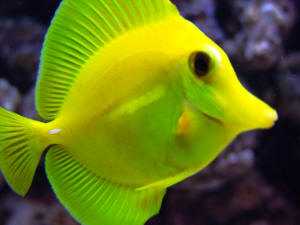 
|
|
|

